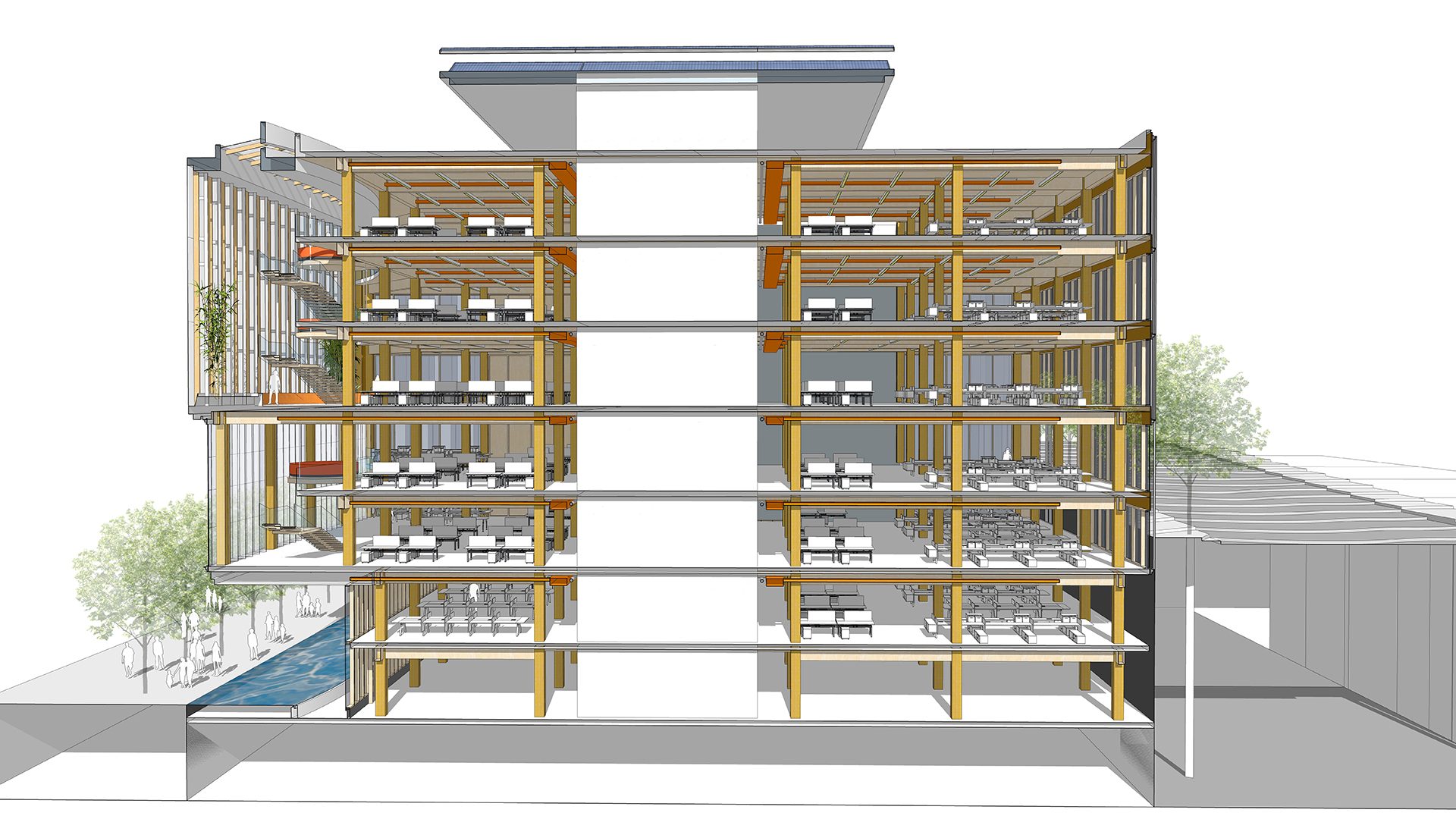Selected by Nature, with Innate Appeal
The Expansive Benefits of Mass Timber Buildings
Written by: Matthias Olt, Design Director, Architecture
As technology, awareness and understanding of this beautiful material advance, we are seeing a world of possibility open up.
B+H recognized the potential of mass timber in 2007 with the successful completion of the Kwantlen Polytechnic University in Surrey, Canada.
Since then we’ve implemented mass timber on several projects, and we are excited to see its accelerated adoption as a material of choice for many different building types at varying scales.
A Very Human Connection
There is real science behind the power of wood and other natural materials to reduce stress, promote a sense of calm and well-being and improve productivity and focus. Scientific research has shown the positive benefits of fresh air, acoustics and daylight on learning, and recent evidence suggests the materiality of a space impacts health, well-being, and personal performance similarly. The sight of bare, synthetic surfaces does not elicit much in the way of a response, but natural materials will. Spaces graced by natural materials such as wood evoke a sense of connection with living things. Environments that feature wood bring nature indoors and trigger positive psychological and physiological responses.
Spending time in rooms constructed with a moderate balance of wooden surfaces reduces Cortisol levels. Cortisol is the body’s primary stress hormone. It works with certain parts of the brain to control mood, motivation, and fear. Cortisol regulates how the body uses carbohydrates, fats, and proteins and regulates the sleep/wake cycle.
Touching wood also reduces the release of another stress indicator, oxyhemoglobin. A Japanese study measured oxyhemoglobin concentrations in the left and right prefrontal cortices and found that oxyhemoglobin levels were about 50 percent lower after touching wood for 90 seconds, compared to touching marble, tile, or metal.
People respond more positively to spaces where wood is present, perceiving wood interiors as warm, inviting, and relaxing.
The Climate Change Generation
In the context of generations, young people who have grown up with the realities of climate change, waste, pollution, resource depletion and population growth are paying attention. They are making decisions about where to study, work and live based on the socio-environmental values of companies and organizations. They are prioritizing those organizations and buildings that make a positive impact on the environment and protect health and well-being.
Cost and Schedule
Construction with engineered wood, or mass timber, is cost competitive to concrete and steel. Although mass timber currently comes with a material cost premium, mass timber buildings are cost-competitive because they can be built much faster and with a reduced on-site crew. Typically, in the range of more than 25 percent faster, shorter construction periods also translate into other financial gain: Build faster, occupy sooner!

Competitive Advantage
Many companies and institutions are recognizing the appeal of mass timber as an essential component of their brand positioning. In response to user and tenant expectations, mass timber not only delivers health and wellness benefits but its amenability to exploration, organic structures and unexpected uses can prove to be a powerful ally in talent attraction and retention by making visible an organization’s identity and core values.
Carbon Sequestration
Producing one ton of concrete emits nearly one ton of carbon dioxide into the atmosphere. By contrast, sustainable wood production sequesters carbon over the lifetime of the building, estimated to last over 100 years.
Structural Resilience, Adaptability and Flexibility
In Northern America, mass timber can currently be used for buildings up to 18 stories tall. The material, when compared to steel or concrete, is extremely strong when used parallel to its grain. Mass timber therefore enables a variety of composite applications with other materials. Unlike reinforced concrete, exposed mass timber components can be easily monitored and replaced over time. Unlike concrete and steel, structural assemblies made of engineered wood can be easily modified to accommodate changing requirements over time. Ancient wooden temples in Japan and timber structures in Europe are testaments to the periodic component replacement and adaptability of wooden structures over centuries. Structures made with mass timber components meet stringent seismic and fire design requirements.
Lightweight Structure facilitates Adaptive Re-Use
The lightweight nature of mass timber compared to steel or concrete offers additional benefits: It reduces the building cost due to lighter substructure and foundations. It also offers an attractive solution for adaptive re-use, where pre-existing foundations can be used for lightweight additions in mass timber.
Government Adoption and Enforcement
The potential of mass timber has been recognized by local, regional, and national jurisdictions around the world. British Colombia in Canada led the way in North America, adopting mass timber technology for tall buildings. In 2018, the International Building Code adopted three new mass timber building types and in 2019 the French government passed a law requiring all new public buildings to be built with no less than 50% biobased materials effective 2022.
Boosting local industries with well-paid factory jobs
The promotion of mass timber by governments is not simply an investment in climate mitigation. Regions whose economies rose and fell with the fate of the traditional forestry industry are seeing the opportunity to create safe, well-paid factory jobs in the modern mass timber economy. The prefabrication of mass timber components shifts construction off-site and reduces vulnerability to on-site labor shortages.
21st Century Ambition
As we look to the future and re-asses what we have, what we need and what we want our urban environments to look like, B+H is looking forward to bringing innovative solutions that leverage the considerable benefits and potential of this exciting new material.